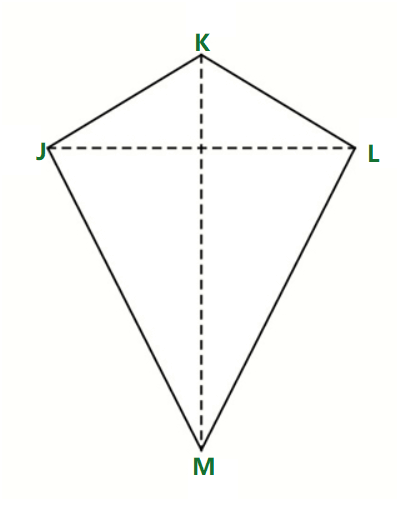
|
|
Kite is a special type of quadrilateral that is easily recognizable by its unique shape, resembling the traditional toy flown on a string. In geometry, a kite has two pairs of adjacent sides that are of equal length. This distinctive feature sets it apart from other quadrilaterals like squares, rectangles, and parallelograms. Diagonals of kite intersect each other at right angles. It is one of the unique quadrilateral and has some interesting properties that are covered below in the article. In this article, we will learn about, Kite Quadrilateral, Properties of kites, Examples, and others, in detail. Table of Content What is a Kite?Kite is a quadrilateral, i.e. it is a polygon with four sides. In a kite, we have 2 pairs of equal-length sides and they are adjacent to each other. The image of a Kite is added below,
Diagonals of a KiteA kite have two diagonals, and the properties of the diagonls of the kite are added below,
Angles in a KiteIn a kite we have four angles, as it a quadrilateral. The properties of the interior angles of the kite are,
Properties of KiteVarious properties of the kite are added below, Theorem: Diagonals of Kite Intersect at Right AnglesThe interesting properties of the kite is that its diagonal are always perpendicular to each other. This is proved below, we have a kite ABCD, whose diagonal intersect each other at point O. In ∆ABD and ∆BCD AB = BC (Property of Kite) AD = CD (Property of Kite) BD = BD (Common Side) >Thus, ∆ABD ≅ ∆BCD (SSS congruency) Now, in ∆ABC and ∆ADC AB = BC (Property of Kite) Hence ∆ABC is an isosceles triangle. AD = CD (Property of Kite) Hence ∆ADC is an isosceles triangle. ∠BAO = ∠BCO BO = BO (Common Side) Thus, ∆ABO ≅ ∆BCO (SAS rule of congruency) Now we know ∠AOB = ∠BOC Also, ∠AOB + ∠BOC = 180° (Linear Pair) Hence, ∠AOB = ∠BOC = 90° Hence diagonals of kite intersect at right angles. Formulas for KiteThere are two common formulas related to kite i.e.,
Area of KiteArea of Kite is calculated by the formula for area of quadrilateral. Generally Area of Kite is calculated by the formula added below,
Perimeter of KitePerimeter of Kite is calculated by adding up the length of sides of the kite. If a Kite ABCD is given then formula is given as
Read More, Solved Examples on KiteExample 1: Find the Area of a Kite whose diagonals are 40 cm and 35 cm. Solution:
Example 2: Find the unknown angles of the kite added in the image below, Given,
Solution:
Example 3: The Area of a kite-shaped field is 450 m² and the length of one of its diagonal is 50 m. A man wants to cross the field through the other diagonal. Find the distance the man has to travel. Solution:
Practice Questions on KiteQ1. Find the area of kite whose one diagonal is 12 cm and other diagonal is 30 cm. Q2. In a kite whose sides are, 5 cm and 8 cm. Find its perimeter. Q3. Find the area of kite whose one diagonal is 7 cm and other diagonal is 3 cm. Q4. In a kite with sides, 21 cm and 23 cm. Find its perimeter. Kites – FAQsWhat is Kite in Geometry?
What are Examples of Kite Shape?
What Area of Kite Formula?
What are Properties of Kite?
What is the Sum of All Angles of Kite?
|
Reffered: https://www.geeksforgeeks.org
| Class 9 |
Type: | Geek |
Category: | Coding |
Sub Category: | Tutorial |
Uploaded by: | Admin |
Views: | 12 |
